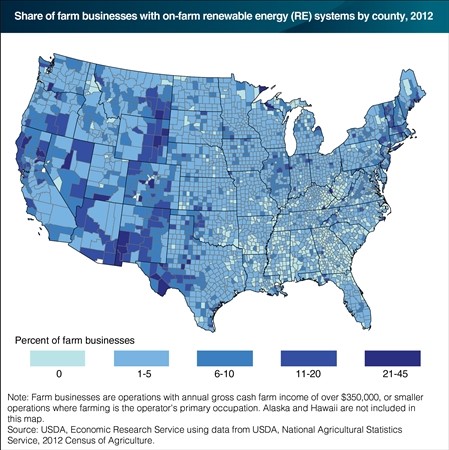WASHINGTON, Nov. 3, 2016 - From 2007 to 2012, the number of farms generating revenue from on-farm renewable energy more than doubled to nearly 58,000 — or 2.7 percent of U.S. farms. That’s according to a recent report from USDA’s Economic Research Service (ERS), “Trends in U.S. Agriculture’s Consumption and Production of Energy: Renewable Power, Shale Energy, and Cellulosic Biomass.”
Farmers and ranchers are also profiting by leasing mineral rights and wind rights. ERS did not include the roughly 16,600 farms that leased wind rights to others or that produced ethanol and biodiesel on the farm in its total.
Adoption of on-farm renewable energy systems varies across the country but is concentrated in the West, New England and in Illinois, the report notes. In these regions, about two in five farm businesses produce renewable energy in some counties. States in the Southeast, which have fewer subsidies and programs supporting renewable power, had low adoption rates. (See map.)
Other findings:
- In 2012, 35 percent of active farm and ranch land was in counties overlaying a shale play (shale counties). Shale plays are geologic formations containing significant amounts of natural gas.
- In 2014, about 6 percent of U.S. farm businesses averaged $56,000 in lease and royalty payments from energy production.
- Acreage in USDA’s Conservation Reserve Program declined by
about 32 percent in shale counties, on average, from 2006 to 2013, compared
with a 22 percent decline in non-shale counties.

- The shale revolution has resulted in declining natural gas and oil prices, which benefit farms with the greatest diesel, gasoline, and natural gas shares of total expenses, such as rice, cotton, and wheat farms. However, domestic fertilizer prices have not substantially fallen despite the large decrease in the U.S. natural gas price (natural gas accounts for about 75-85 percent of fertilizer production costs). This is due to the relatively high cost of shipping natural gas, which has resulted in regionalized natural gas markets, as compared with the more globalized fertilizer market.
- The Clean Power Plan (CPP) may result in greater electricity rate increases for agricultural and other rural customers than for the average retail customer, due to rural electric cooperatives’ greater share of electricity generation from coal. However, direct-use electricity expenses of farm businesses represent only about 1-6 percent of total production expenses, suggesting relatively the CPP will have relatively small impacts on most farm businesses.
#30
For more news, go to: www.Agri-Pulse.com

